|
A
C I D I F I C A T I O N
PLEASE USE OUR A-Z INDEX
TO NAVIGATE THIS SITE OR SEE
HOME
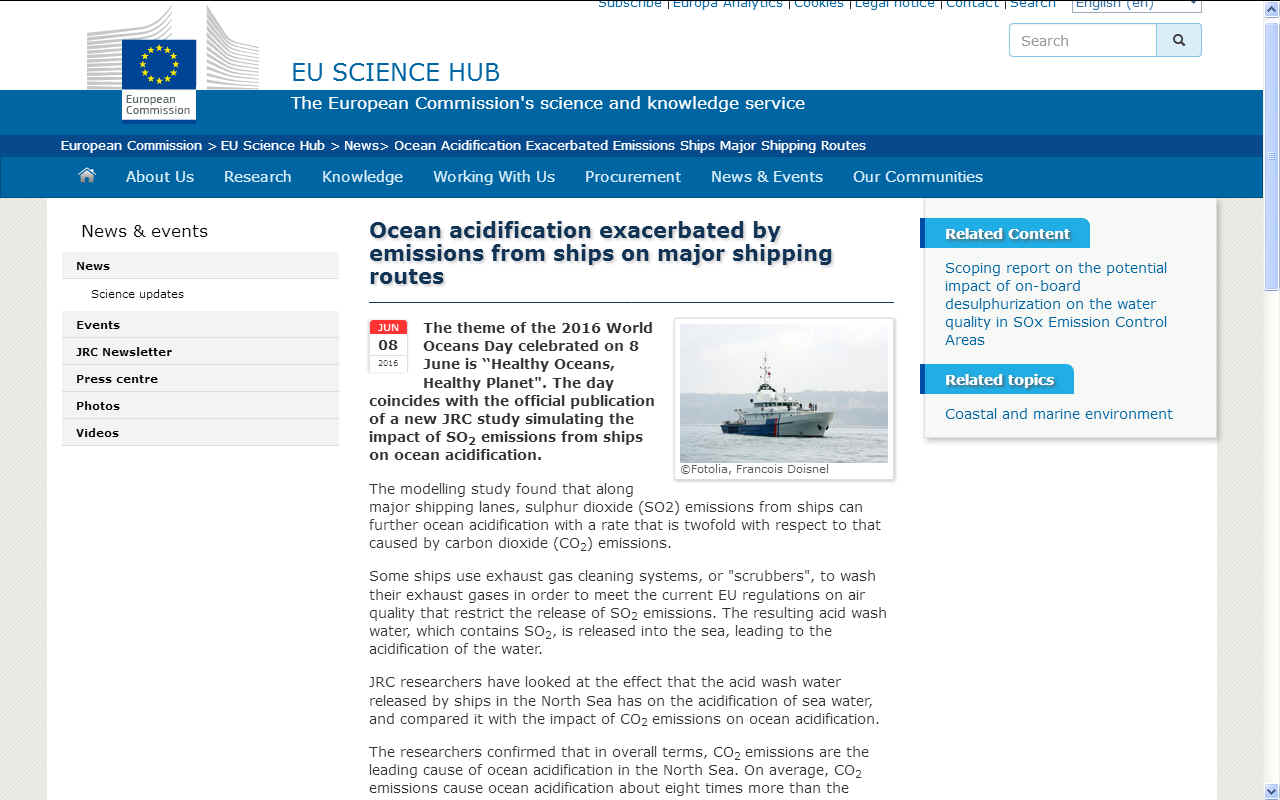
Although air
pollution from ships does not have the direct cause and effect associated with, for example, an
oil spill
incident, it causes a cumulative effect that contributes to the overall air quality problems encountered by populations in many areas, and also affects the natural environment, such as tough acid rain.
This
is linked to carbon
dioxide increases, also from internal
combustion engines on land and at sea (and coal
burning), where the ocean has absorbed about 30 percent of the carbon dioxide humans
have sent into the atmosphere since the start of the
Industrial Revolution – some 150 billion tons.
Ocean acidification – sometimes referred to as climate change's evil twin – refers to the ongoing decrease in the pH of the Earth's
oceans. It is the consequence of substances such as CO2 and SO2 that dissolve into the ocean and change the ocean’s chemistry.
The theme of the 2016 World Oceans Day celebrated on 8 June is “Healthy Oceans, Healthy Planet". The day coincides with the official publication of a new JRC study simulating the impact of SO2 emissions from ships on
ocean
acidification.
The modelling study found that along major shipping lanes, sulphur dioxide (SO2) emissions from ships can further ocean acidification with a rate that is twofold with respect to that caused by carbon dioxide (CO2) emissions.
Some ships use exhaust gas cleaning systems, or "scrubbers", to wash their exhaust gases in order to meet the current EU regulations on
air quality that restrict the release of
SO2 emissions. The resulting acid wash water, which contains SO2, is released into the sea, leading to the acidification of the water.
JRC researchers have looked at the effect that the acid wash water released by ships in the North Sea has on the acidification of sea water, and compared it with the impact of
CO2 emissions on ocean acidification.
The researchers confirmed that in overall terms, CO2 emissions are the leading cause of ocean acidification in the
North
Sea. On average, CO2 emissions cause ocean acidification about eight times more than the release of acid water from ships. However, JRC researchers found that in certain areas where ship traffic is very intense, the impact of SO2 emissions on ocean
acidification can be up to 20 times greater than the average impact calculated for the whole North Sea area. In these areas, the impact of
acid water release from ships is also two times higher than that of the increasing CO2 emissions.
The researchers also found that the increased SO2 levels influence the capacity of sea water to resist the changes in pH levels. Consequently, for every tonne of SO2 released into the water, the North Sea absorbs about half a tonne less of CO2, with respect to its usual capacity.
The study indicates that there might be potential problems related to the surface water quality – in particular with regard to
water acidification – in some critical areas, i.e. ports, estuaries and coastal waters, that are subject to the current
EU water and marine regulations.
Ocean
acidification also affects whole
ecosystems, such as coral
reefs, which depend on the formation of calcium carbonate to
build reef structure, which in turn provides homes for reef
organisms.
Acidification also appears to be reducing the amount
of sulfur flowing out of the ocean into the atmosphere. This reduces reflection of solar radiation back into space,
resulting in even more warming.
This is the kind of positive feedback loop that could result
in run-away climate change – and of course, even more
disastrous effects on the ocean.
MARPOL
In 1997, a new annex was added to the International Convention for the Prevention of Pollution from Ships (MARPOL)
administered by the International
Maritime Organization (IMO). The regulations for the Prevention of Air
Pollution from Ships (Annex VI) seek to minimize airborne emissions from ships (SOx, NOx, ODS, VOC shipboard incineration) and their contribution to local and global ai r pollution and environmental problems. Annex VI entered into force on 19 May 2005 and a revised Annex VI with significantly tightened emissions limits was adopted in October 2008 which entered into force on 1 July 2010.
MARPOL Annex VI, first adopted in 1997, limits the main
air pollutants contained in ships exhaust gas, including sulphur oxides (SOx) and nitrous oxides (NOx), and prohibits deliberate emissions of ozone depleting substances (ODS).
MARPOL Annex VI also regulates shipboard incineration, and the emissions of volatile organic compounds (VOC) from tankers.
Following entry into force of MARPOL Annex VI on 19 May 2005, the Marine Environment Protection Committee (MEPC), at its 53rd session (July 2005), agreed to revise
MARPOL Annex VI with the aim of significantly strengthening the emission limits in light of technological improvements and implementation experience. As a result of three years examination, MEPC 58 (October 2008) adopted the revised MARPOL Annex VI and the associated NOx Technical Code 2008, which entered into force on 1 July 2010.
Sulphur oxides
(SOx) and Particulate Matter (PM) – Regulation 14
SOx and particulate matter emission controls apply to all fuel
oil, as defined in regulation 2.9, combustion equipment
and devices onboard and therefore include both main and
all auxiliary engines together with items such boilers
and inert gas generators.
These controls divide between
those applicable inside
Emission Control Areas (ECA) established to limit the emission of SOx and
particulate matter and those applicable outside such
areas and are primarily achieved by limiting the maximum
sulphur content of the fuel oils as loaded, bunkered,
and subsequently used onboard. These fuel oil sulphur
limits (expressed in terms of % m/m – that is by mass)
are subject to a series of step changes over the years,
regulations 14.1 and 14.4:
Outside an ECA established to limit SOx and particulate
matter emissions
Inside an ECA established to limit SOx and particulate matter
emissions
|
4.50% m/m prior to 1 January 2012
1.50% m/m prior to 1 July 2010
|
|
3.50% m/m on
and after 1 January 2012
1.00% m/m on
and after 1 July 2010
|
|
0.50% m/m on
and after 1 January 2020*
0.10% m/m on
and after 1 January 2015
|
* as required under
regulation 14, a review as to the availability of the
required fuel oil was undertaken. MEPC 70 (October 2016)
considered an assessment of fuel oil availability and it
was decided that the fuel oil standard (0.50% m/m) shall
become effective on 1 January 2020 (resolution
MEPC.280(70)).
The ECAs established are:
Baltic Sea area – as defined in Annex I of
MARPOL (SOx only); North Sea area – as defined in Annex V of MARPOL
(SOx only); North American area (entered into effect 1 August
2012) – as defined in Appendix VII of Annex VI of
MARPOL (SOx, NOx and PM);
and United States Caribbean Sea area (entered into
effect 1 January 2014) – as defined in Appendix
VII of Annex VI of MARPOL (SOx, NOx and PM).
Most ships which operate
both outside and inside these ECA will therefore operate
on different fuel oils in order to comply with the
respective limits. In such cases, prior to entry into
the ECA, it is required to have fully changed-over to
using the ECA compliant fuel oil, regulation 14.6, and
to have onboard implemented written procedures as to how
this is to be undertaken. Similarly change-over from
using the ECA compliant fuel oil is not to commence
until after exiting the ECA. At each change-over it is
required that the quantities of the ECA compliant fuel
oils onboard are recorded, together with the date, time
and position of the ship when either completing the
change-over prior to entry or commencing change-over
after exit from such areas. These records are to be made
in a logbook as prescribed by the ship's flag State, in
the absence of any specific requirement in this regard
the record could be made, for example, in the ship's
Annex I Oil Record Book.
The first level of
control in this respect is therefore on the actual
sulphur content of the fuel oils as bunkered. This value
is to be stated by the fuel oil supplier on the bunker
delivery note and hence this, together with other
related aspects, is directly linked to the fuel oil
quality requirements as covered under regulation 18.
Thereafter it is for the ship's crew to ensure, in
respect of the ECA compliant fuel oils, that through
avoiding loading into otherwise part filled storage,
settling or service tanks, or in the course of transfer
operations, that such fuel oils do not become mixed with
other, higher sulphur content fuel oils, so that the
fuel oil as actually used within an ECA exceeds the
applicable limit.
Consequently, regulation
14 provides both the limit values and the means to
comply. However, there are other means by which
equivalent levels of SOx and
particulate matter emission control, both outside and inside
ECA, could be achieved. These may be divided into
methods termed primary (in which the formation of the
pollutant is avoided) or secondary (in which the
pollutant is formed but subsequently removed to some
degree prior to discharge of the exhaust gas stream to
the atmosphere).
Regulation 4.1 allows for the
application of such methods subject to approval by the
Administration. In approving such equivalents an
Administration should take into account any relevant
guidelines. As of October 2010 there are no guidelines
in respect of any primary methods (which could
encompass, for example, onboard blending of liquid fuel
oils or dual fuel (gas / liquid) use). In terms of
secondary control methods, guidelines (
MEPC.259(68))
have been adopted for exhaust gas cleaning systems which
operate by water washing the exhaust gas stream prior to
discharge to the atmosphere, in using such arrangements
there would be no constraint on the sulphur content of
the fuel oils as bunkered other than that given the
system's certification.
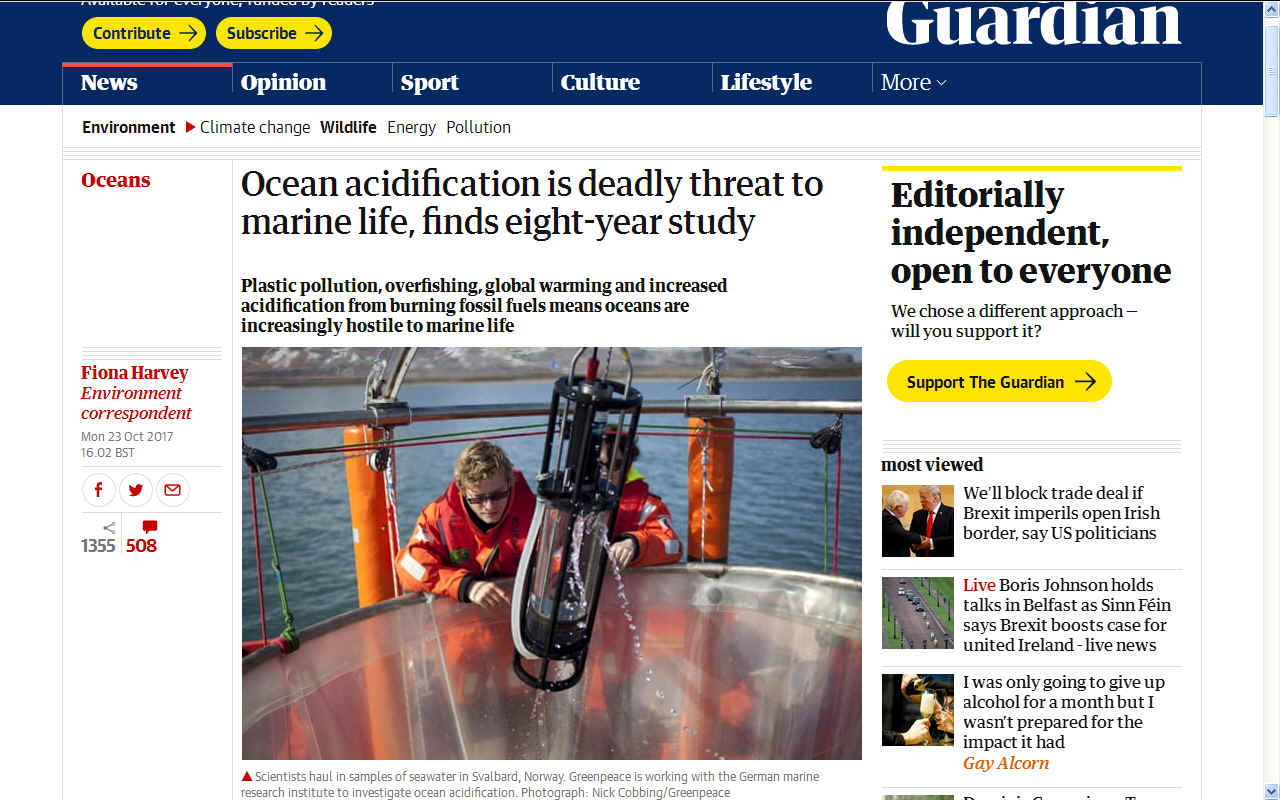
THE
GUARDIAN OCTOBER 2017 - Ocean acidification is deadly threat to marine life, finds eight-year study
Plastic pollution, overfishing,
global warming and increased acidification from burning
fossil fuels means oceans are increasingly hostile to marine life
If the outlook for marine life was already looking bleak – torrents of plastic that can suffocate and starve fish, overfishing, diverse forms of human pollution that create dead zones, the effects of global warming which is bleaching
coral reefs and threatening coldwater species – another threat is quietly adding to the toxic soup.
Ocean acidification is progressing rapidly around the world, new research has found, and its combination with the other threats to marine life is proving deadly. Many organisms that could withstand a certain amount of acidification are at risk of losing this adaptive ability owing to pollution from plastics, and the extra stress from
global
warming.
The conclusions come from an eight-year study into the effects of ocean acidification which found our increasingly acid seas – a byproduct of burning
fossil fuels – are becoming more hostile to vital marine life.
“Since ocean acidification happens extremely fast compared to natural processes, only organisms with short generation times, such as micro-organisms, are able to keep up,” the authors of the study Exploring Ocean Change:
Biological Impacts of Ocean Acidification found.
Marine life such as crustaceans and organisms that create calcified shelters for themselves in the oceans were thought to be most at risk, because acid seas would hinder them forming shells. However, the research shows that while these are in danger, perhaps surprisingly, some – such as barnacles – are often unaffected, while the damage from acidification is also felt much higher up the food chain, into big food fish species.
Ocean acidification can reduce the survival prospects of some species early in their lives, with knock-on effects. For instance, the scientists found that by the end of the century, the size of Atlantic cod in the Baltic and Barents Sea might be reduced to only a quarter of the size they are today, because of acidification.
Peter Thomson, UN ambassador for the oceans and a diplomat from Fiji, which is hosting this year’s UN
climate change conference in Bonn, urged people to think of the oceans in the same terms as they do the climate. “We are all aware of climate change, but we need to talk more about ocean change, and the effects of acidification, warming, plastic pollution, dead zones and so on,” he said. “The world must know that we have a plan to save the ocean. What is required over the next three years is concerted action.”
The eight-year study was carried out by the Biological Impacts of Ocean Acidification group (known as Bioacid), a
German network of researchers, with the support of the German government, and involved more than 250 scientists investigating how marine life is responding to acidification, and examining research from around the world. The study was initiated well before
governments signed a global agreement on climate change at Paris in
2015, and highlights how the Paris agreement to hold warming to no more than 2C may not be enough to prevent further acidification of the world’s seas.
Governments will meet in Bonn in November to discuss the next steps on the road to fulfilling the requirements of the Paris agreement, and the researchers are hoping to persuade attendees to take action on ocean acidification as well.
Ocean acidification is another effect of pouring carbon dioxide into the atmosphere, as the gas dissolves in seawater to produce weak carbonic acid. Since the industrial revolution, the average pH of the ocean has been found to have fallen from 8.2 to 8.1, which may seem small but corresponds to an increase in acidity of about 26%. Measures to reduce the amount of carbon dioxide reaching the atmosphere can help to slow down this process, but only measures that actively remove carbon already in the atmosphere will halt it, because of the huge stock of carbon already in the air from the burning of fossil fuels.
Worse still, the effects of acidification can intensify the effects of
global
warming, in a dangerous feedback loop. The researchers pointed to a form of planktonic alga known as Emiliania huxleyi, which in laboratory experiments was able to adapt to some extent to counter the negative effects acidification had upon it. But in a field experiment, the results were quite different as the extra stresses present at sea meant it was not able to form the extensive blooms it naturally develops. As these blooms help to transport carbon dioxide from the surface to the deep ocean, and produce the gas dimethyl sulfide that can help suppress global warming, a downturn in this species “will therefore severely feed back on the climate system”.
By Fiona Harvey
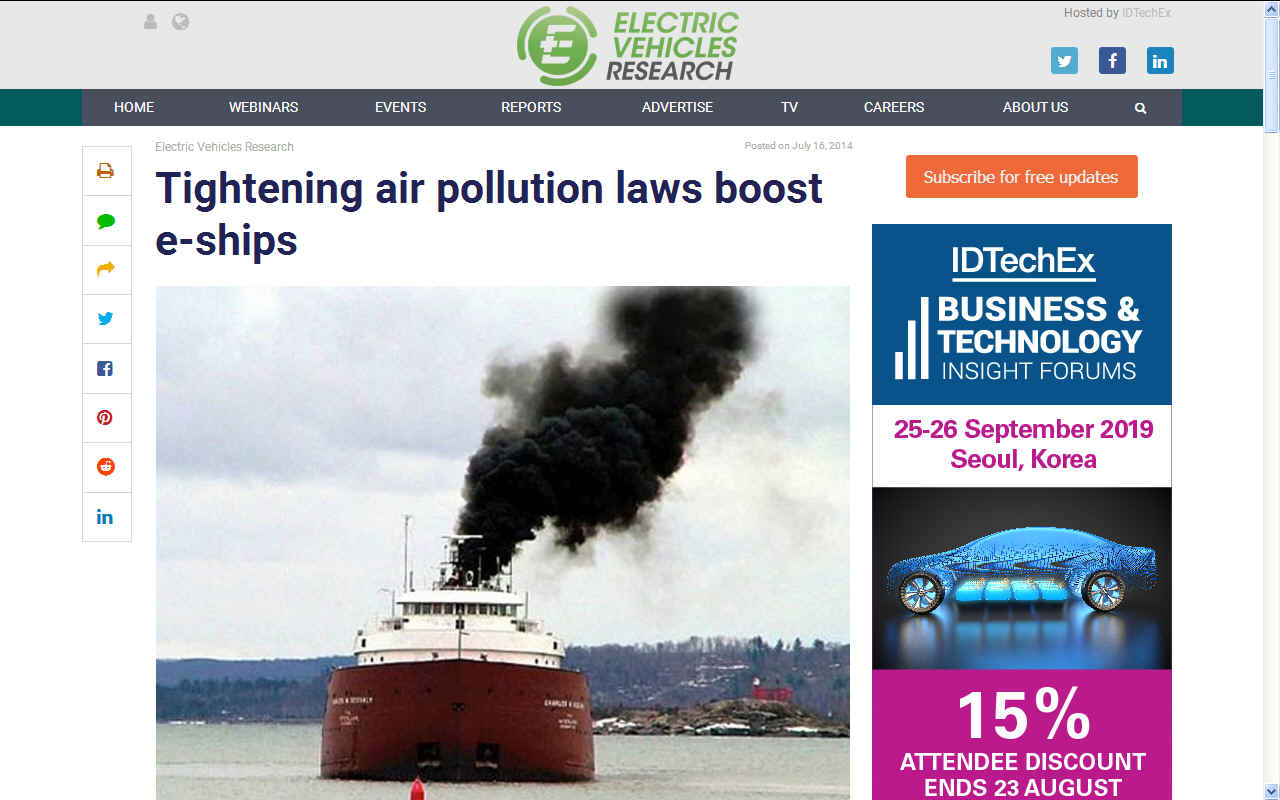
ELECTRIC
VEHICLE RESEARCH JULY 16 2014 - Tightening air pollution laws boost e-ships
In two parts of the world — along the U.S. and Canadian coasts, and in the Baltic and North seas as well as the English Channel — the SOx limits are ultra-strict. As of 2010, the sulfur content of marine fuel in these "emission control areas" must be 1 percent or lower. As of 2015, the sulfur content must be 0.1 percent or lower.
These limits explain Totem Ocean Trailer's conversion of its Alaska fleet to LNG as well as Shell's move to make LNG for ships plying the Great Lakes, Mississippi River and Gulf of Mexico coast.
For ships sailing on the open ocean and along other coasts, the sulfur content of their fuel can be 3.5 percent now, a limit that will shrink to 0.5 percent in either 2020 or 2025, depending on cleaner marine-fuel availability.
But neither of these LNG advantages — lower price and pollution — come for free.
The Sulphur Emission Control Area (SECA) will affect all shipping within, into and out of the Baltic, North Sea and English Channel from January 2015. While the introduction of the SECA is justified by the need to reduce sulphur emissions, which have a significant impact on human health, it is likely to damage the economics of longer distance roll-on roll-off (roro) services that help to remove traffic from the Scottish and GB road networks unless hybrids are successful - just changing fuel is not usually economic.
SECA will limit fuel emissions from ships to 0.1% sulphur compared to the current limit of 1.5%. This initiative by the International Maritime Organization and the European Union is justified by the likely positive impacts on human health, buy many observers of the maritime industry believe there will be a significant impact on the economics of ferry services operating to, from and within the SECA. This is because Heavy Fuel Oil (HFO), which is the cheapest marine fuel, will be banned unless the ships' emissions are cleaned using "scrubber" technology - which requires investment by shipping lines that will have to be paid for by their customers in the medium - to long-term. Marine Gas Oil (MGO), the main existing alternative fuel, is much more expensive than HFO.
Liquid Natural Gas (LNG) may provide a cheaper alternative fuel for new ferries in the future, but very few large commercial roro vessels with LNG engines have been built, the retrofit of LNG engines does not appear to be possible and, in any event the refuelling infrastructure is unlikely to be available in many ports by 1 January 2015. However, there is a promising move to hybrid and pure electric sea-going boats and ferries etc.
Motivated in part by serious urban air pollution, the Chinese government last year issued a new Natural Gas Utilization Policy. It calls for more dual-fuel cars and LNG vehicles, plus LNG or dual-fuel ships on rivers, lakes and along the country's coast.
The number of LNG marine filling stations doubled in 2012, reaching 385, mostly located near coastal cities, the LNG association said.
Nonetheless it is unclear whether LNG fuel on its own can leverage its two most winning features — a cost advantage and less pollution — into a sizeable market share in the transportation industry.
On price, LNG is about $1.50 a gallon cheaper than diesel at today's oil and natural gas costs in North America. Clean Energy says its LNG price in California averaged $2.91 per gallon of diesel equivalent last year, compared with a diesel fuel average of $4.23. In Asia, LNG might not have much price advantage because, unlike in North America, so much LNG is sold there at oil-linked prices.
On pollution, new International Maritime Organization rules strictly limit sulfur oxide emissions by ships. Ordinary diesel and heavy fuel oil emit a lot of sulfur oxide when burned. LNG has virtually zero SOx emissions.
For trucks, the build-out of LNG fuelling stations has only just begun. For ships, northern Europe has a few LNG refuelling ports and a couple other ports there are manoeuvring for position. Singapore also hopes to become a refuelling hub.
Further, conversion costs are high. Studies conclude this is a new build option only, unless grants are forthcoming.
The Staten Island Ferry system is using a $2.3 million federal grant to help pay for converting one ferry to natural gas, according to the American Gas Association.
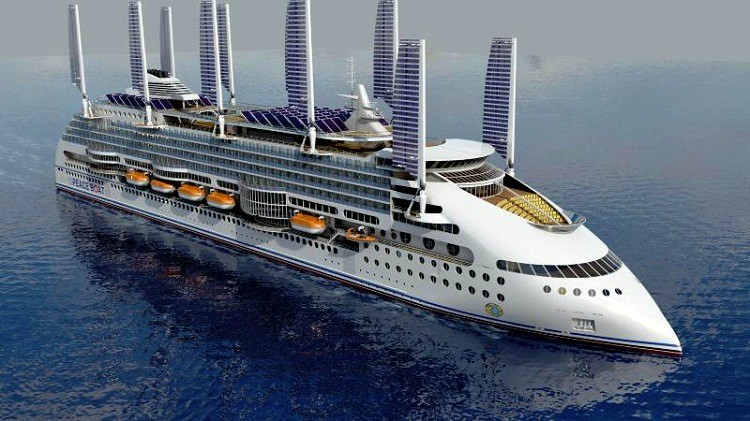
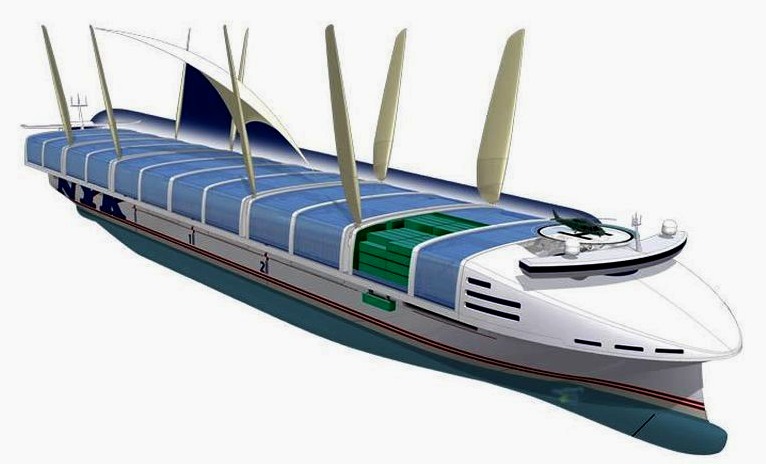
TRANSFERABLE
TECHNOLOGY - The design of the Climate
Change Challenger* might be adapted to Cargo, Container,
Cruise and Ferry designs, without needing to radically alter
port facilities. The designs above are not representative of
adaptations of the concept, but serve to illustrate the
thinking of other design houses.
Once
proven, scaled up versions of the Challenger might be phased
in from 2030, with help from a scrappage
scheme and taxation
on marine
diesel fuels for internal
combustion engines.
*
A project aiming to design, build and field a zero carbon
(solar and wind powered) yacht from 2020.
New Hybrid Ship and Boat Technology
Many companies are launching new hybrid ship and boat technology to work with less polluting fuel where viable. Other technology boosts the case for pure electric powertrains in boats, including some light duty tugboats.
For example Saft, the world's leading designer and manufacturer of advanced technology batteries for industry, is launching its new Seanergy® range of lithium-ion (Li-ion) battery modules developed to offer the proven safety, performance and reliability advantages of Li-ion Super-Iron Phosphate® (SLFP) chemistry in a fully integrated solution designed specifically for civil marine propulsion installations. The new range includes a variety of Energy and Power modules that offer the flexibility and adaptability to create highly efficient, cost-effective battery systems to power full-electric and hybrid electric applications for a wide variety of vessels including work boats, ferries, offshore support, cruise-liners and cargo ships.
"Silent, clean and cost-effective operations are now key priorities for the marine transportation industry," says Didier Jouffroy, Saft's Marine Products and Applications Manager. "That's why Saft has responded by developing the Seanergy range that offers the advantages of our advanced SLFP battery chemistry in a safe, reliable and flexible modular package."
The trend for electric propulsion is being driven by the needs of the civil marine industry to demonstrate that it is sustainable and energy efficient. This means it has to adapt fast to meet ever tighter environmental regulations that aim to reduce both emissions and noise nuisance while increasing efficiency. New concepts in ship architecture are now incorporating advanced battery technology for both pure electric propulsion and hybrid systems, where the batteries work in conjunction with diesel generators, or possibly gas turbines, and electric motors.
Saft's current marine Li-ion battery projects include: Ballerina's brand new electric ferry boat for the city of Stockholm; Icade's electric-powered passenger vessel operated on Paris' Saint-Denis' canal by Vedettes de Paris; two Keolis hybrid diesel-electric ferryboats that operate a shuttle service across the Garonne river in Bordeaux.
SLFP advantages
The key advantages of Saft SLFP cell technology for marine applications are its increased safety, its light weight and compact size, high efficiency, long calendar and cycling life, fast-charging capability and high power output - both continuous and in pulses and the ability to deliver high voltages - up to 1000 V.
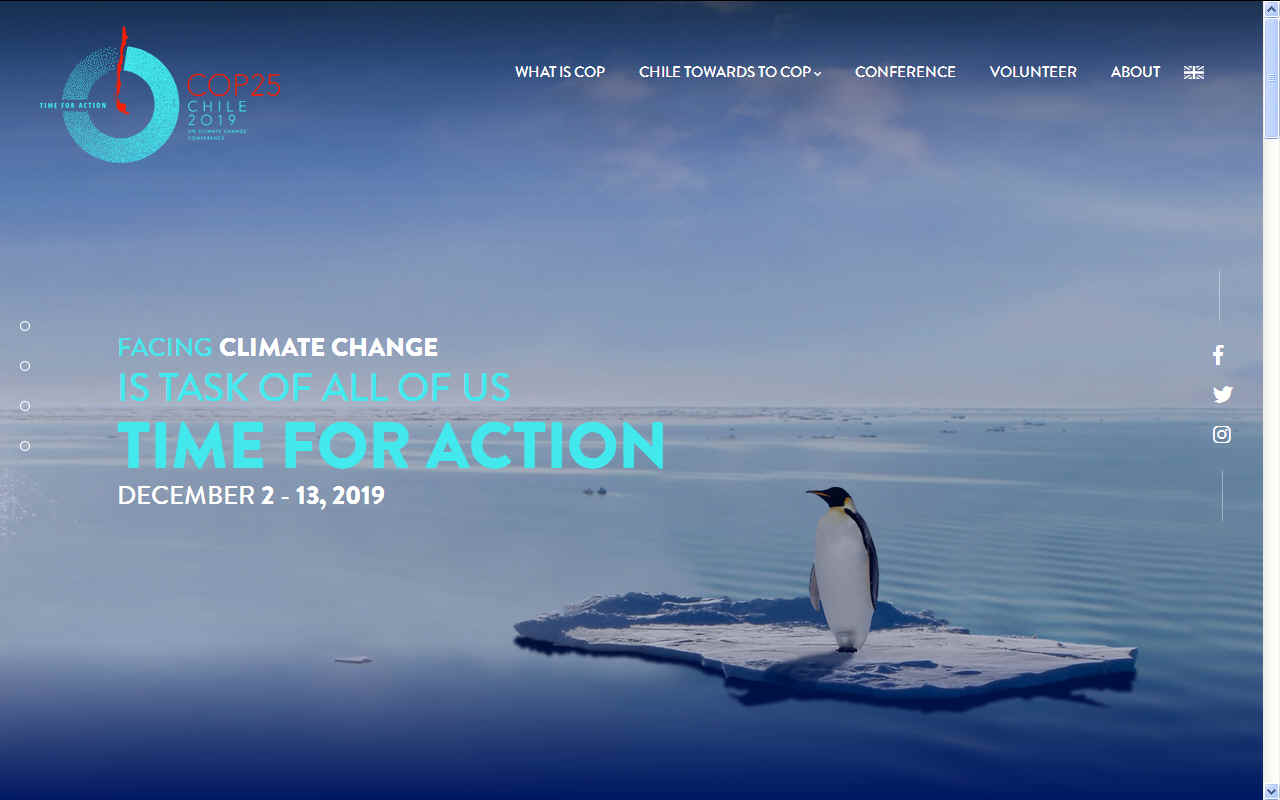
CLIMATE
CHANGE UN COP HISTORY
|
1995
COP 1, BERLIN, GERMANY
1996
COP 2, GENEVA, SWITZERLAND
1997
COP 3, KYOTO, JAPAN
1998
COP 4, BUENOS AIRES, ARGENTINA
1999
COP 5, BONN, GERMANY
2000:COP
6, THE HAGUE, NETHERLANDS
2001
COP 7, MARRAKECH, MOROCCO
2002
COP 8, NEW DELHI, INDIA
2003
COP 9, MILAN, ITALY
2004
COP 10, BUENOS AIRES, ARGENTINA
2005
COP 11/CMP 1, MONTREAL, CANADA
2006
COP 12/CMP 2, NAIROBI, KENYA
2007
COP 13/CMP 3, BALI, INDONESIA
|
2008
COP 14/CMP 4, POZNAN, POLAND
2009
COP 15/CMP 5, COPENHAGEN, DENMARK
2010
COP 16/CMP 6, CANCUN, MEXICO
2011
COP 17/CMP 7, DURBAN, SOUTH AFRICA
2012
COP 18/CMP 8, DOHA, QATAR
2013
COP 19/CMP 9, WARSAW, POLAND
2014
COP 20/CMP 10, LIMA, PERU
2015
COP 21/CMP 11, Paris, France
2016
COP 22/CMP 12/CMA 1, Marrakech, Morocco
2017
COP 23/CMP 13/CMA 2, Bonn, Germany
2018
COP 24/CMP 14/CMA 3, Katowice, Poland
2019
COP 25/CMP 15/CMA 4, Santiago, Chile
2020
COP 26/CMP 16/CMA 5, to be announced
|
DESERTIFICATION
COP HISTORY
|
COP
1:
Rome, Italy, 29 Sept to 10 Oct 1997
|
COP
9:
Buenos Aires, Argentina, 21 Sept to 2 Oct 2009
|
|
COP
2:
Dakar, Senegal, 30 Nov to 11 Dec 1998
|
COP
10:
Changwon, South Korea, 10 to 20 Oct 2011
|
|
COP
3:
Recife, Brazil, 15 to 26 Nov 1999
|
COP
11:
Windhoek, Namibia, 16 to 27 Sept 2013
|
|
COP
4:
Bonn, Germany, 11 to 22 Dec 2000
|
COP
12:
Ankara, Turkey, 12 to 23 Oct 2015
|
|
COP
5:
Geneva, Switzerland, 1 to 12 Oct 2001
|
COP
13:
Ordos City, China, 6 to 16 Sept 2017
|
|
COP
6:
Havana, Cuba, 25 August to 5 Sept 2003
|
COP
14:
New Delhi, India, 2 to 13 Sept 2019
|
|
COP
7:
Nairobi, Kenya, 17 to 28 Oct 2005
|
COP
15:
2020
|
|
COP
8:
Madrid, Spain, 3 to 14 Sept 2007
|
COP
16: 2021
|
ACIDIFICATION
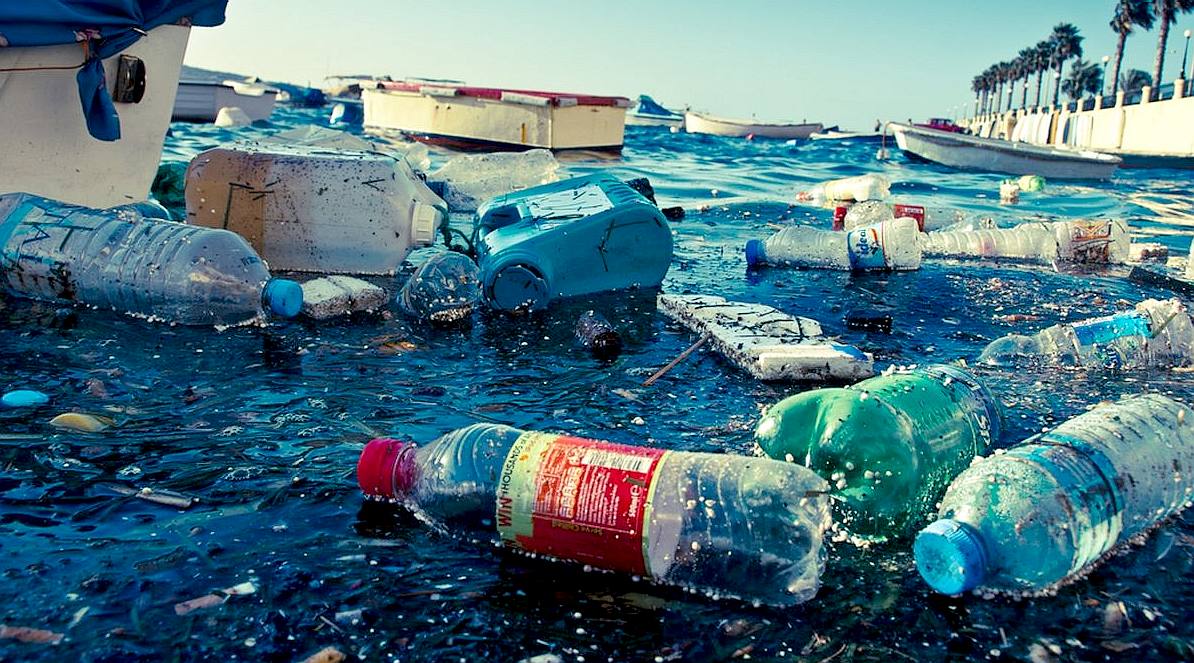
FAST
FOOD SLOW DEATH - It's not just fast food, it
is our exploitative society that is poisoning the planet, without thought
for the consequences. We've been living at artificially low prices at the
expense of killing other life on earth. Eat cheap now and suffer later, with
health services picking up the tab and costing the taxpayer more than if
we'd dealt with ocean dumping up front.
It
is possible to turn the tide of plastic into a revenue stream
and at the same time reduce climate change - where plastic
packaging has a smaller carbon
footprint than other packaging mediums.
LINKS
& REFERENCE
http://unfccc.int/meetings/bonn_nov_2017/meeting/10084.php
http://www.bioacid.de/
http://oceanrep.geomar.de/view/project/BIOACID.html
http://www.oceanacidification.de/category/video-en/?lang=en
https://www.electricvehiclesresearch.com/articles/6715/tightening-air-pollution-laws-boost-e-ships
https://www.theguardian.com/environment/2017/oct/23/ocean-acidification-deadly-threat-to-marine-life-finds-eight-year-study
https://ec.europa.eu/jrc/en/news/ocean-acidification-exacerbated-emissions-ships-major-shipping-routes
https://www.theclimatecoalition.org/
https://www.sas.org.uk/our-work/climate-change/
https://en.wikipedia.org/wiki/School_strike_for_climate
https://www.climatechangenews.com/2019/04/11/chile-reveals-venue-climate-champion-cop25-summit/
https://www.independent.co.uk/news/uk/politics/climate-change-environment-emergency-commons-motion-mps-vote-latest-a8895456.html
This website is
provided on a free basis as a public information service. copyright © Cleaner
Oceans Foundation Ltd (COFL) (Company
No: 4674774) 2022.
Solar
Studios, BN271RF, United Kingdom.
COFL is
a company without share capital.
|






